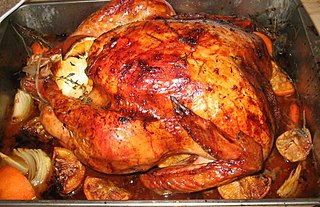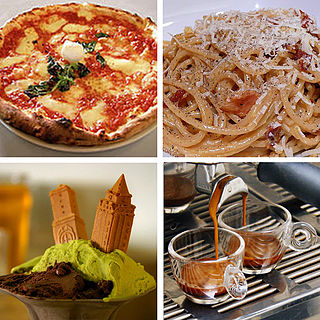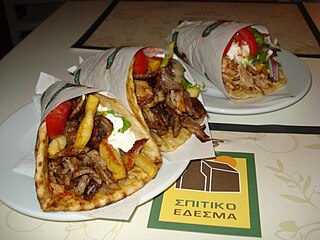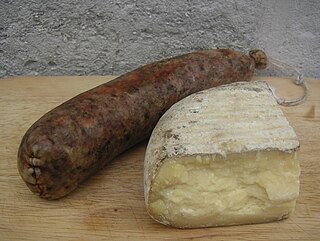
Danish cuisine originated from the peasant population's own local produce and was enhanced by cooking techniques developed in the late 19th century and the wider availability of goods during and after the Industrial Revolution. Open sandwiches, known as smørrebrød, which in their basic form are the usual fare for lunch, can be considered a national speciality when prepared and garnished with a variety of ingredients. Hot meals are typically prepared with meat or fish. Substantial meat and fish dishes includes flæskesteg and kogt torsk with mustard sauce and trimmings. Ground meats became widespread during the industrial revolution and traditional dishes that are still popular include frikadeller, karbonader and medisterpølse. Denmark is known for its Carlsberg and Tuborg beers and for its akvavit and bitters, but amongst the Danes themselves imported wine has gained steadily in popularity since the 1960s.
Norwegian cuisine in its traditional form is based largely on the raw materials readily available in Norway and its mountains, wilderness, and coast. It differs in many respects from continental cuisine through the stronger focus on game and fish. Many of the traditional dishes are the result of using conserved materials, necessary because of the long winters.

Cypriot cuisine is the cuisine of the island of Cyprus, shared by both Greek Cypriots and Turkish Cypriots.The national dish is seftalia (greek:σεφταλιά)

Italian-American cuisine is a style of Italian cuisine adapted throughout the United States. Italian-American food has been shaped throughout history by various waves of immigrants and their descendants, called Italian Americans.

Christmas dinner is a meal traditionally eaten at Christmas. This meal can take place any time from the evening of Christmas Eve to the evening of Christmas Day itself. The meals are often particularly rich and substantial, in the tradition of the Christian feast day celebration, and form a significant part of gatherings held to celebrate the arrival of Christmastide. In many cases, there is a ritual element to the meal related to the religious celebration, such as the saying of grace.

Italian cuisine is a Mediterranean cuisine consisting of the ingredients, recipes and cooking techniques developed in Italy since Roman times and later spread around the world together with waves of Italian diaspora. Some of these foods were imported from other cultures. Significant changes occurred with the colonization of the Americas and the introduction of potatoes, tomatoes, capsicums, maize and sugar beet—the latter introduced in quantity in the 18th century. It is one of the best-known and most appreciated gastronomies worldwide.

Chilean cuisine stems mainly from the combination of traditional Spanish cuisine, Chilean Mapuche culture and local ingredients, with later important influences from other European cuisines, particularly from Germany, the United Kingdom and France. The food tradition and recipes in Chile are notable for the variety of flavours and ingredients, with the country's diverse geography and climate hosting a wide range of agricultural produce, fruits and vegetables. The long coastline and the peoples' relationship with the Pacific Ocean add an immense array of seafood to Chilean cuisine, with the country's waters home to unique species of fish, molluscs, crustaceans and algae, thanks to the oxygen-rich water carried in by the Humboldt Current. Chile is also one of the world's largest producers of wine and many Chilean recipes are enhanced and accompanied by local wines. The confection dulce de leche was invented in Chile and is one of the country's most notable contributions to world cuisine.

Tunisian cuisine, the cuisine of Tunisia, consists of the cooking traditions, ingredients, recipes and techniques developed in Tunisia since antiquity. It is mainly a blend of Mediterranean and native Punics-Berber cuisine. Historically, Tunisian cuisine witnessed influence and exchanges with many cultures and nations like Italians, Andalusians, French and Arabs.

Neapolitan cuisine has ancient historical roots that date back to the Greco-Roman period, which was enriched over the centuries by the influence of the different cultures that controlled Naples and its kingdoms, such as that of Aragon and France.

Italian meal structure is typical of the European Mediterranean region and differs from Northern, Central, and Eastern European meal structure, though it still often consists of breakfast (colazione), lunch (pranzo), and supper (cena). However, much less emphasis is placed on breakfast, and breakfast itself is often skipped or involves lighter meal portions than are seen in non-Mediterranean Western countries. Late-morning and mid-afternoon snacks, called merenda, are also often included in this meal structure.

Cappon magro is an elaborate Genoese salad of seafood and vegetables over hardtack arranged into a decorative pyramid and dressed with a rich sauce.

Greek-American cuisine is the cuisine of Greek Americans and their descendants, who have modified Greek cuisine under the influence of American culture and immigration patterns of Greeks to the United States. As immigrants from various Greek areas settled in different regions of the United States and became "Greek Americans," they carried with them different traditions of foods and recipes that were particularly identified with their regional origins in Greece and yet infused with the characteristics of their new home locale in America. Many of these foods and recipes developed into new favorites for town peoples and then later for Americans nationwide. Greek-American cuisine is especially prominent in areas of concentrated Greek communities, such as Astoria, Queens and Tarpon Springs, Florida.

The traditional cuisine of Abruzzo is eclectic, drawing on pastoral, mountain, and coastal cuisine. Staples of Abruzzo cuisine include bread, pasta, meat, fish, cheese, and wine. The isolation which has characterized the region for centuries has ensured the independence of its culinary tradition from those of nearby regions. Local cuisine was widely appreciated in a 2013 survey among foreign tourists.
Barbadian cuisine, also called Bajan cuisine, is a mixture of African, Portuguese, Indian, Irish, Creole, Indigenous and British background. A typical meal consists of a main dish of meat or fish, normally marinated with a mixture of herbs and spices, hot side dishes, and one or more salads. The meal is usually served with one or more sauces.

Menorcan cuisine refers to the typical food and drink of Menorca.

Apulian cuisine consists of the cooking traditions and practices of the region of Apulia in Italy. Starting from the Middle Ages the permanent residence of the nobility in the region gradually declined, which caused the disappearance of their noble cuisine over time. As the common people suffered from poverty, their culinary tradition adapted to use cheap and simple foods. Bread, vegetables and pasta have the leading role in the cuisine. Fruits, fish and wine are consumed frequently as well, but meat plays a minor role. The food of Apulia is known as a prime example of cucina povera or 'cuisine of the poor', characterizing its simplicity rather than its quality. Moreover, the simple dishes allow the quality of their local and seasonal ingredients to take center stage.










